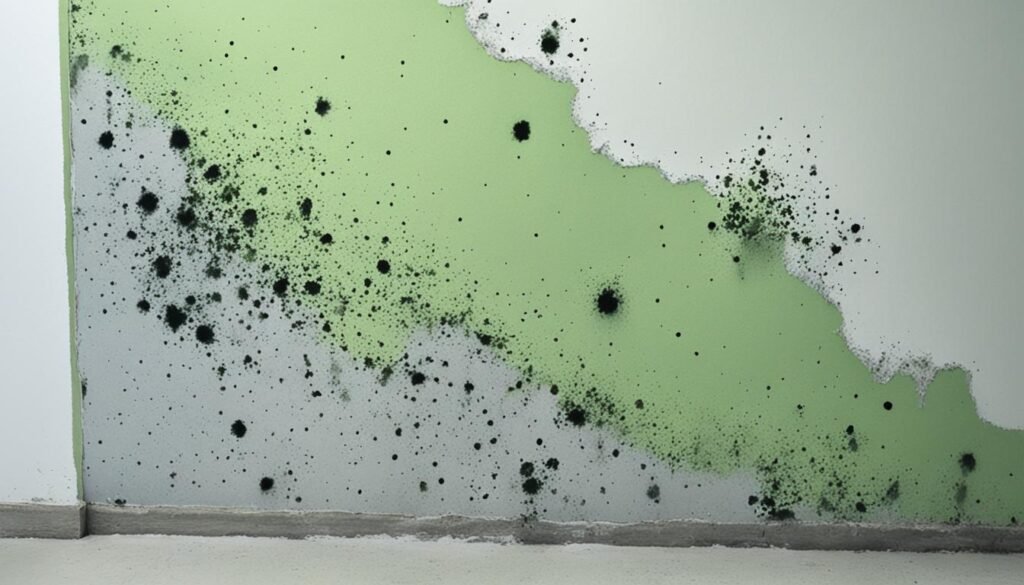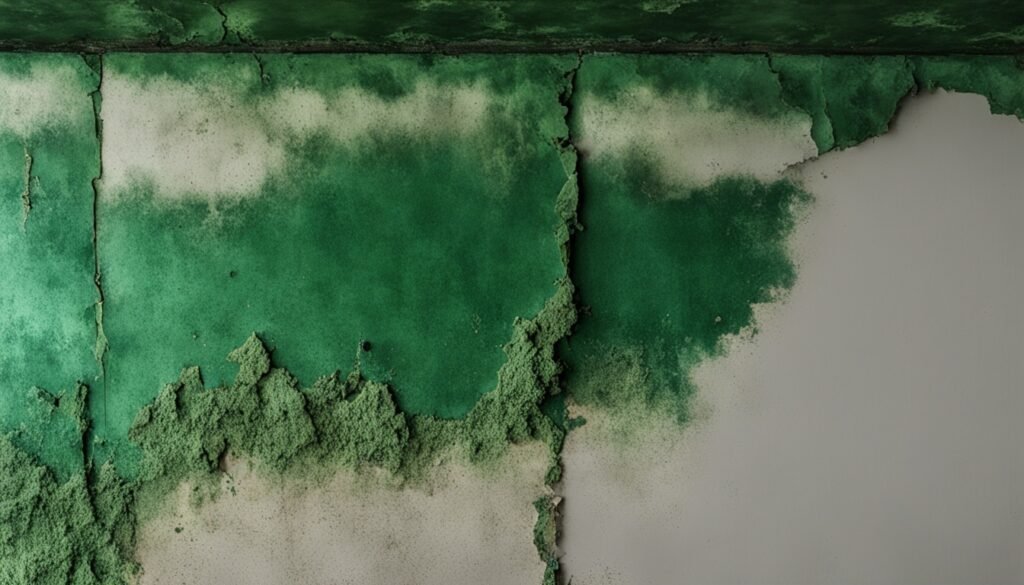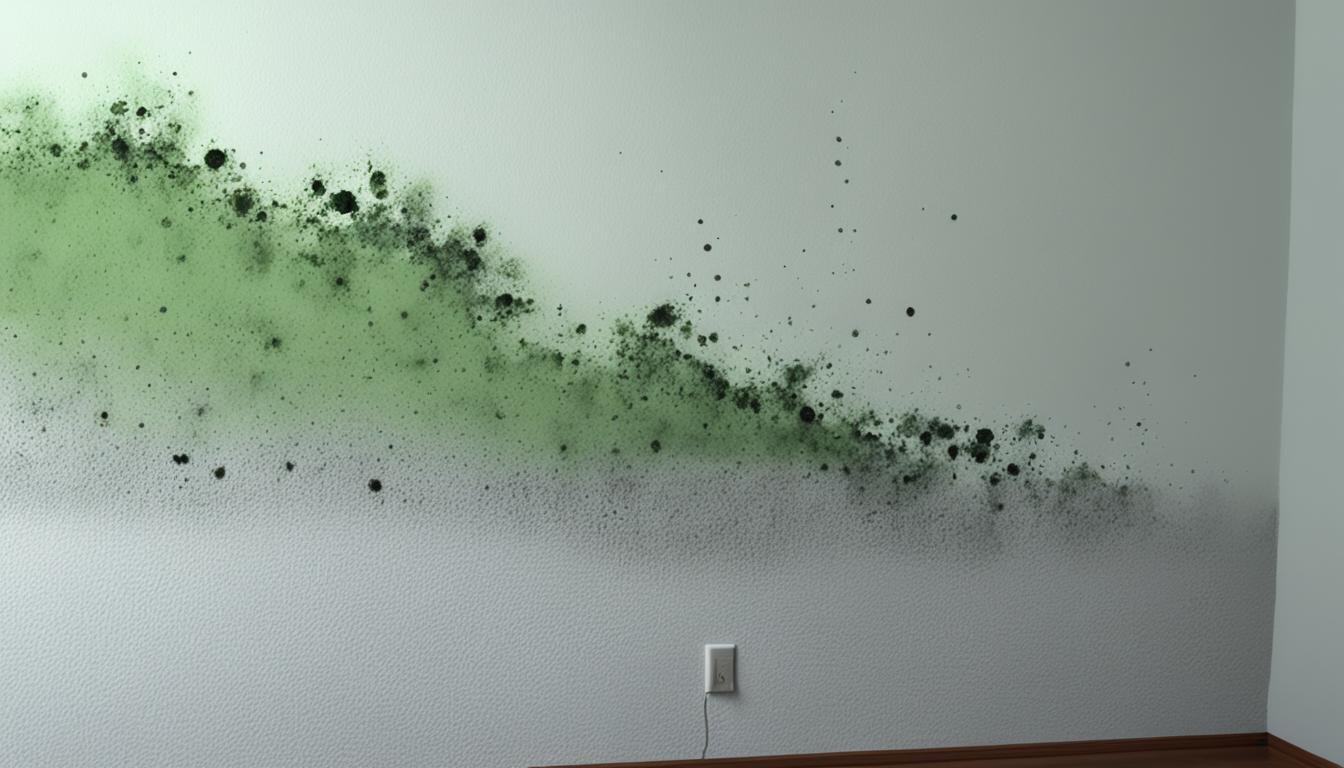Did you know the EPA says to get professional help if over 10 square feet of mold is found in a home? Mold on drywall can be harmful, causing health risks and structural issues. It’s important for homeowners to think through if they should replace moldy drywall. This decision depends on how much mold there is, the type, and the drywall’s condition.
In many cases, replacing moldy drywall is a must. It stops the mold from spreading and keeps your home safe. Mold can cause health problems, especially for kids and older adults. Drywall also plays a big role in keeping a home strong and insulated. If mold isn’t dealt with, it can move from the drywall to the insulation and outer walls, which could cause more damage.
Sometimes, you can’t see mold inside walls. Using regular household items to clean it might not work. It’s best to have pros check and fix the problem, like those at Water Damage Pros – San Bernardino. They know how to handle mold safely and repair or replace the drywall. Waiting to take action on moldy drywall could lead to more issues and costs over time.
Key Takeaways
- Mold growth on drywall can pose serious health risks and structural damage to a home.
- Replacing moldy drywall is often necessary to prevent the mold from spreading and ensure a safe, healthy living environment.
- Professional restoration companies are equipped to evaluate, safely remove mold infestations, and conduct drywall repair and replacement.
- Ignoring moldy drywall can lead to worsening problems and greater costs in the long run.
- Water Damage Pros – San Bernardino offers expert mold remediation and drywall repair services.
Identifying Mold Growth on Drywall
Finding mold on drywall isn’t just about looks. It can weaken your home and make you sick. Knowing how to spot mold’s signs is the first step to tackle this issue.
Common Signs of Mold on Drywall
You can tell when there’s mold on drywall by certain marks. Look out for:
- Dark, spotty stains on the surface
- Fuzzy or slimy growth in irregular patterns
- Discoloration ranging from brown or black to green or pink
- Bubbling or peeling of paint or wallpaper
- A persistent musty odor
When you see these signs, it means mold and moisture have damaged the drywall. Early detection is key as molds can spread fast.
Types of Mold on Drywall
Different mold types can grow on drywall. They have various looks and where they thrive. Some common ones are:
| Mold Type | Characteristics |
|---|---|
| Black Mold | A common and potentially toxic variety that thrives in excessively moist environments. |
| White Mold | Often mistaken for efflorescence, this type of mold can grow in cool, damp areas. |
| Blue and Green Mold | These types are also common, typically found in bathrooms, basements, and other high-humidity spaces. |
Finding out the mold type helps in choosing the right clean-up method.

“Mold can spread quickly if unnoticed, potentially leading to extensive damage to homes.”
Should Moldy Drywall Be Replaced?
The choice to replace moldy drywall depends on how much mold is there and the drywall’s condition. If the mold goes deep, it weakens the drywall. This makes changing it the best move. Mold is not good for health, especially for those with breathing issues.
But sometimes, special treatments can kill the mold without swapping the drywall. Yet, with severe mold, like black mold, changing the drywall is safer. It ensures your home is free of mold and safe to live in.
- Moldy drywall can cause major health concerns if ignored.
- Experts often say to swap moldy drywall instead of fixing it.
- Not all mold in drywall is visible, so careful replacement is often needed.
Getting rid of the mold is vital as it can lead to many health problems, from allergies to asthma. Children and older adults are especially at risk. It’s best to hire a pro for this risky job.
“Mold damage on drywall can come from roof leaks or poor vapor barriers. It can stick to drywall’s paper face and cause harm over time. This can seriously affect health.”
If mold has gone deep into the drywall, it’s hard to fully remove. In such cases, replacing it all is needed. Drywall isn’t great in very wet areas. Using concrete fiber backer board is better in those places.
Deciding whether to swap moldy drywall is about looking at how bad the mold is and if the drywall’s strong enough. Also, consider the health risks. Talking to a pro can guide you to the best decision for your home.

Removing Mold from Painted Drywall
Finding mold on painted drywall can be distressing. But, you might clean it without replacing the drywall. To do this, use a strong cleaning solution, have good air circulation, and make sure the area dries thoroughly.
Cleaning Mold on Painted Drywall
To clean off mold on painted walls, pick a good mold-killing cleaner. You can use:
- A mixture of bleach and water
- A solution of baking soda and water
- White vinegar and water
First, open windows and doors for fresh air. This is to keep any mold spores that move in the air from settling elsewhere. Also, cover items around the mold to stop it from spreading.
Then, use the cleaning mix on the mold area. Scrub it well to get rid of the mold. Make sure the area is completely dry. A box fan left running for a day can help a lot.
Preventing Mold Regrowth
To keep mold from coming back, use special paint products. A mold-killing primer and mold-resistant paint can help. Also, keep the room’s humidity low, between 30-50%.
| Cleaning Solution | Effectiveness | Considerations |
|---|---|---|
| Bleach and Water | Effective for surface mold | Can be harmful if not used properly |
| Baking Soda and Water | Gentle, effective for small areas | May require more scrubbing |
| White Vinegar and Water | Effective for a wide range of mold | Acidic, may damage some surfaces |
If the mold goes through the paint and hits the drywall, you might need to replace it. Often, talking to a pro in mold removal is the best move when it’s this serious.
Conclusion
Moldy drywall is a serious problem for your health and home’s structure. It’s important to act fast when you spot it. You can choose to have it removed professionally with mold remediation, or you can replace the drywall.
Don’t wait if you see mold on your walls. The problem will only get worse and cost more to fix. Always stay alert for signs of mold.
Contact experts like Water Damage Pros – San Bernardino for help. They can safely remove the mold. This protects your house’s structure and your family’s health.
Make sure your home’s air is clean and fix any water issues. This stops mold from coming back. Investing in expert services is the smart choice for your family’s safety.
Being watchful and acting quickly can keep your home free from mold. This helps keep your house a healthy and happy place to live for many years.
FAQ
Should moldy drywall be replaced?
How can I identify mold growth on drywall?
What types of mold can grow on drywall?
When is it necessary to replace moldy drywall?
Can I remove mold from painted drywall without replacement?
Source Links
- https://www.disasterkleen.com/should-i-replace-moldy-drywall/
- https://www.haysandsons.com/blog/how-to-remove-mold-from-walls
- https://www.home-repair-central.com/removing-moldy-drywall.html
- https://ask.metafilter.com/124182/How-can-I-find-out-if-there-is-mold-behind-my-drywall
- https://www.forbes.com/home-improvement/interior/how-to-remove-mold-from-drywall/
- https://www.osha.com/blog/identifying-mold-types
- https://www.litehousepainting.com/home-tips/repair-replace-mold-infested-drywall
- https://bernardibuildingsupply.com/replacing-mold-damaged-drywall/
- https://www.turbotenant.com/blog/mold-on-drywall/
- https://www.mypureenvironment.com/post/does-moldy-drywall-always-need-to-be-replaced/
- https://www.thisoldhouse.com/walls/22215480/remove-mold-on-drywall
- https://www.mold-answers.com/mold-on-drywall.html
- https://patchmaster.com/article/columbia-how-to-know-if-you-should-replace-repair-drywall
- https://upperrestoration.com/is-it-time-to-replace-your-drywall-signs-to-look-out-for/


